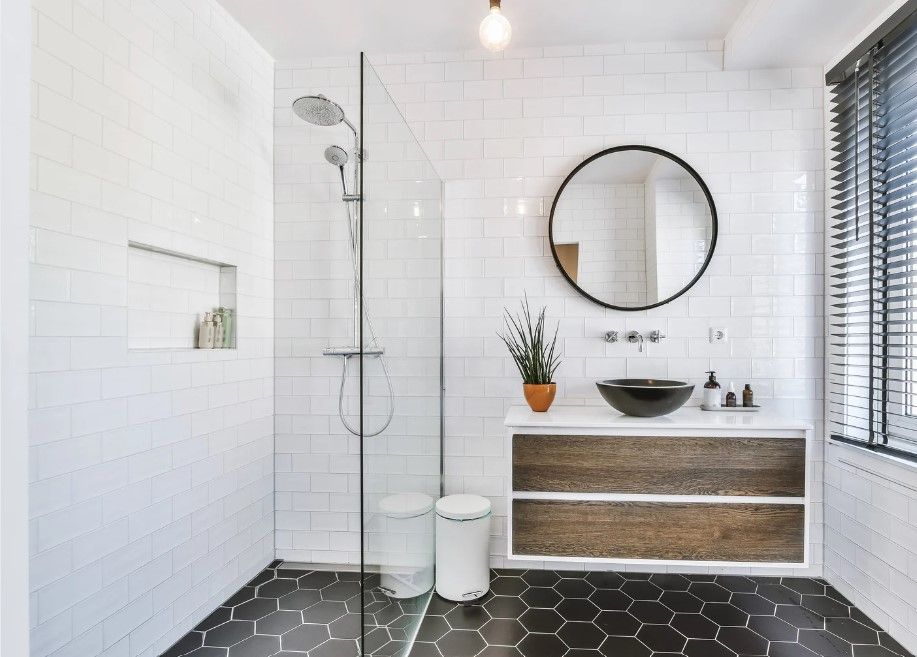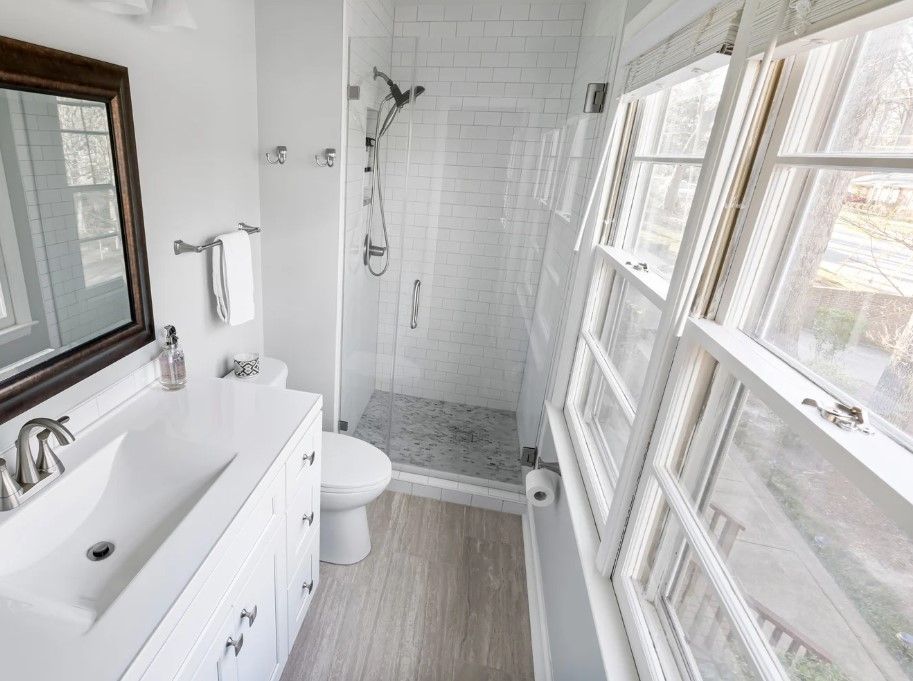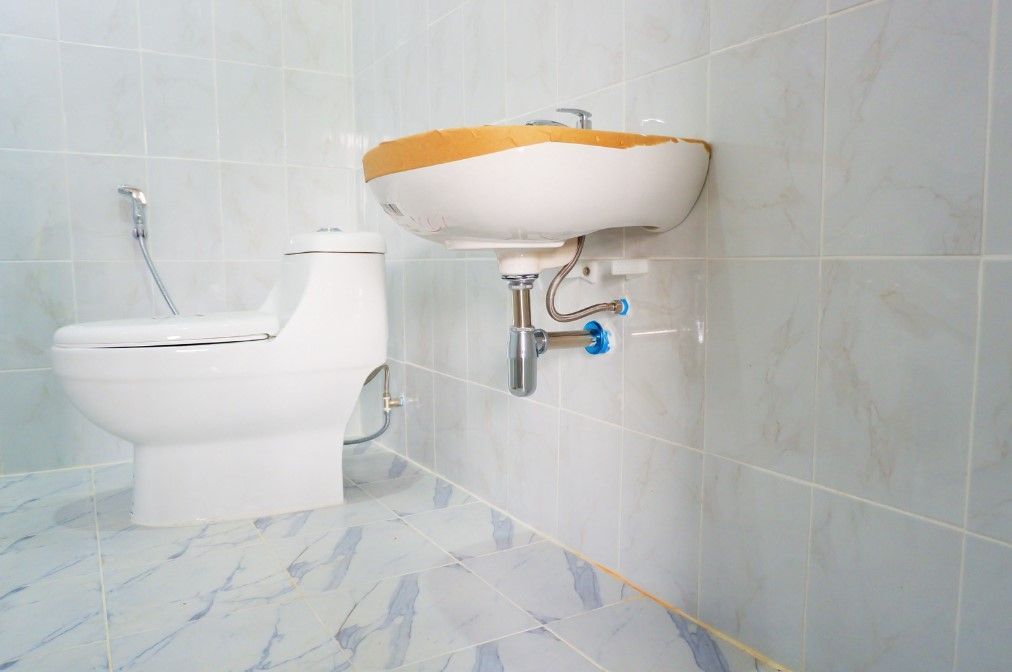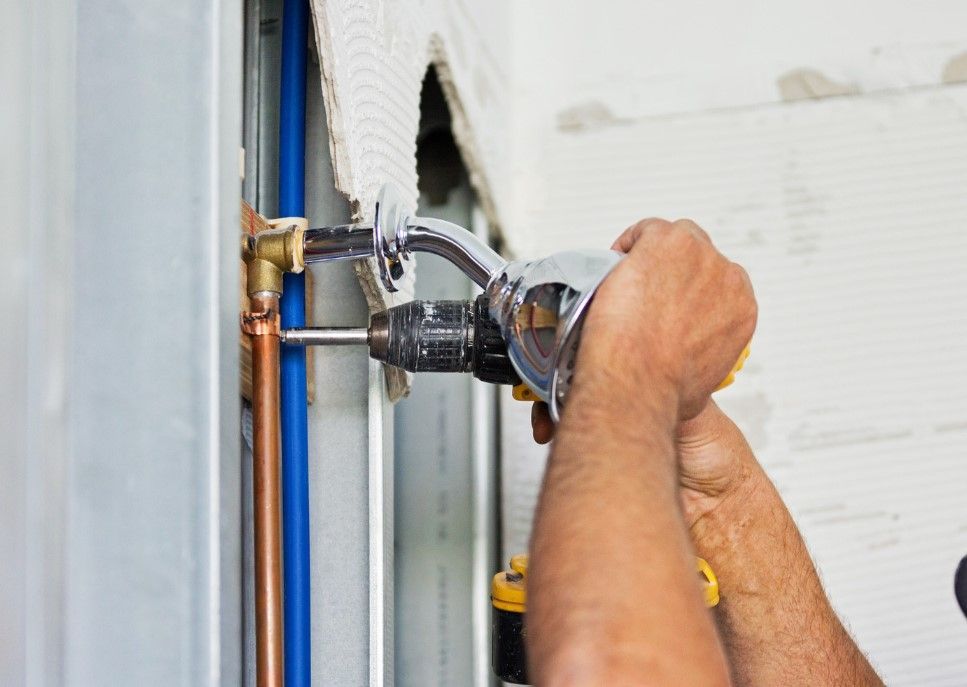GET A QUICK FREE WET ROOM or BATHROOM INSTALLATION QUOTE
SEND 24/7
Bathroom Fitter enquiry
We will get back to you as soon as possible.
Please try again later.
BATHROOM FITTER DERBY
With Derbyshire Plumbing & Heating Specialists you will be dealing with one of the top-rated Bathroom fitting companies in the Derby. You can count on us to provide you with the professional tiling services along with all the plumbing services required to transform your bathroom. Our company has been working in and around Derby and Derbyshire for many years and we can help you get exactly what you want for your new bathroom from design to completion, or simply install all the items you have already selected and bought.
Whether you are looking for installations, repairs, or a transformation, you can trust us to help. Installing a great looking bathroom is what we enjoy and the results are often breath-taking.
We are here to support you and to help to ensure that you get the bathroom you've been dreaming of competitively priced for the quality of services we'll provide to give you high-quality results. We have the experience and the expertise required to give you the bathroom re-fit you have been dreaming of simply get in touch today.

Slide title
Write your caption hereButton
Slide title
Write your caption hereButton
BATHROOM FITTERS NEAR ME
If you live in Derby or further afield in Derbyshire we bring our service to you. So if you are looking for bathroom fitters near me, we're ideal!
WET ROOM DERBY
When talking about wet rooms there are different interpretations of exactly what constitutes a wet room. Purists of definitions will say that a true wet room has no separate shower tray nor doors or screens. However, in the real world, not many people will have the luxury of having such space in a bathroom which allows a completely open shower without the risk of other items in the bathroom getting wet. A wet room is not going to be much fun if you have to go round wiping down sinks, toilets and cupboards every time you’ve finished showering!
So without getting too hung up about exact definitions a wet room is, it will certainly be more ‘open’ and minimalistic than a fully self-contained shower unit. The level of this openness will need to be decided on a case by case basis based on your space, desired utility positions, style, budget and the existing structure of your walls and floors. As part of Derbyshire Specialists Group we have the resources and expertise to provide many possible options to provide you with an end result that will delight you.
WET ROOM INSTALLER DERBY
There are many options and configurations for your wet room from a completely open plan one, to using existing walls to provide some containment and possibly a single shower screen to provide some level of water containment. You can have a single screen with access to the shower from both sides, or utilise two existing walls and include a shower screen to enclose the other side creating a ‘U’ shape enclosure.
The location of a wet room will also impact what may need to be done to create a watertight zone. Most wet rooms have historically been located on ground floors due to the solid floor on which they can be build and as a result, many wet rooms do provide an ideal environment for elderly or wheelchair-bound individuals.
Upstairs wet room installation will generally be a more involved process with the main goal being to ensure that the floor surface of the wet room is on a rigid base with no possible movement. This may involve adding additional flooring supports under the main wet room area of the bathroom. For our wet room experts, this is all part of the installation process and we’ve installed many wet rooms on the ground, first floors and even loft conversion - so it’s all possible.
When dealing with water-related projects should something go wrong you don’t want to be in a position of trying to decide which contractor needs to sort out the problem. For example is a possible water leak the result of poor tiling, grouting or sealing, has the plumber not securely fitted a section of pipework, has the base not been properly supported to prevent any movement or flexing in the floor area? With one company there is one guarantee, so with only one company accountable - you’ll know they’ll want to do the job right first time, every time! With our ability to floor tile, wet room board, install underfloor heating and floor level we're adept at transforming and bathroom or indeed any room into a fantastic wet room.
WET ROOM INSTALLERS
If you live in Derby or further afield in Derbyshire our wet room installers can transform your showering experience - get in touch today!
BATHROOM TILING & SHOWER BOARD INSTALLATION
When it comes to making a decision on the materials to use in a bathroom there are a number of material choices for both walls floors and the shower unit itself.
For wet room walls, depending on how you are going to use the layout of your bathroom you can use tiles or shower boards, sometimes referred to as shower wall panels. Both are popular options with shower boards being specified more since they are seen as a lower maintenance option as there is no grout to gradually pick up dirt. The decision of shower wall panels or tiles is completely up to you. Shower boards will vary in price points, as will wall tiles. At the lower end, shower boards will have quite a plastic look and feel to them but at the top end they have some very interesting designs, which will create quite a wow factor and certain manufacturers will have matching worktops - so you can continue the same design across your sink and storage units too.
With tiles, there are many, many more options with the ability to mix and match so you can have a completely bespoke design by deciding how you may want to integrate feature tiles with plain tiles and whether to go for a mosaic effect or utilise larger tiles, which will minimise the amount of exposed grout. Even when it comes to grout there are a number of colour options – grout doesn’t only come in white so if you are perhaps wanting to minimise cleaning whilst keeping your wet room looking like a new, slightly darker tiling and grout for the wet room area can be used to identify that space as the shower area.
As mentioned earlier – typically a ‘true’ wet room will not have a visible shower tray although this doesn’t necessarily mean that you can’t or shouldn’t have one. There may be occasions where we may advise the use of a shower tray which is most likely to be at an upstairs level where the main joists used in the house are of lower quality and amount of deflection, or movement, will mean that the water-tightness of a standard tiled wet room floor may be at risk, even with re-enforcement, due to the amount of floor movement. Unfortunately, this scenario is generally more common in new properties with certain house builders. However, shower trays have also come a long way in recent years and slate effect low-level trays can look stunning.
BATHROOM RENOVATION DERBY
If you live in or around Derby and are looking to renovate your bathroom get in touch today to arrange a quote
SHOWER INSTALLER DERBY
When it comes to installing a new shower, you have two main options: electric showers and those integrated with a home's hot water system. Each type comes with its own set of considerations and installation requirements.
Electric Showers
Electric showers are self-contained units that heat water on demand. This means you don’t need a hot water supply, making them ideal for homes with limited hot water availability. However, several key factors must be considered: Electric showers typically require a dedicated circuit due to their high wattage, often ranging from 8 to 10 kilowatts. Rather than a plumber a qualified electrician should assess the existing electrical system to ensure it can handle the load and install the appropriate circuit breaker. (As part of Derbyshire Specialists Group we have access to a highly experienced electrician)
Electric showers perform best with adequate water pressure. If your home has low water pressure, the shower’s performance may be compromised, leading to inadequate water flow and a poor shower experience.
Hot Water System Showers
Shower installations connected to a hot water system take hot water from your home’s boiler or hot water tank. Key considerations include simultaneous water usage to ensure there’s a consistent supply of hot water. If you have a large family a simple system may struggle to provide sufficient hot water for simultaneous use (like cooking or laundry), so you may need to upgrade your hot water heater split how hot water is distributed around your home between boiler and hot water tank. As part of us checking suitability we will inspect the existing plumbing to determine if it meets the necessary standards for shower installation. Corroded or damaged pipes may need replacement before installing the new shower and new pipework is likely to need running to the position of your new shower, the amount will depend how far it is from other sources such as a sink.
We will also check the pressure and flow rate from your hot water system. Ideally, you want a consistent pressure to maintain a comfortable shower experience throughout duration of use. From a safety perspective we would advise installing a thermostatic mixing valve to control the temperature and prevent scalding should a dramatic change in pressure occur whilst in use. This enhances safety, especially for families with children. Whichever you choose we will provide impartial advice and can install either.
TOILET INSTALLATION DERBY
Installing a toilet can be fairly straight forward but if you’re considering changing its position this can be a much more involved process Relocating a toilet involves more than just moving the fixture; it requires careful planning and understanding of plumbing systems and also an appreciation of building construction. If you are looking to relocate your toilet we will assess the existing plumbing, ensuring that the new location allows for easy access to water supply and waste lines. We need to assess how easily waste can get to the soil stack, which is the external draining pipe, which takes waste away from your home. We will give you an honest appraisal which will be reflected in any quotation.
If you are changing a toilet's position, it’s the opportune time to consider upgrading the toilet itself. Upgrading to a modern, water-efficient toilet can save you money on water bills while benefiting the environment. Dual-flush models, for example, let you choose between two flush levels depending on the waste, optimising water usage. Depending on your budget, you might explore features like heated seats, bidet attachments, or touchless flush systems for enhanced comfort and convenience.
As well as installation we handle toilet repairs such as leaky seals, cracked bowls, or broken handles - all of which can lead to water damage if not fixed promptly so be sure to keep an eye out.
BATHROOM CUPBOARDS, CABINET & VANITY UNIT FITTERS
There are many options when it comes to cupboards and vanity units. Whilst you many not have made final decision on colour before work start on your bathroom it is prudent to have decided and size and location during the bathroom design process to ensure fitting is a straight forward process and you are not going to spend more on having aspects of your bathroom changed once work has already been completed in some areas.
The least problematic vanity unit is a freestanding vanity: As the name suggests, it is a standalone piece of furniture that does not require support from a wall. It gives a classic and elegant look to the bathroom and is a good option if you have a large bathroom area, and a flat floor. A wall-mounted vanity is attached to the wall with screws or brackets and is excellent for small bathrooms with limited space, especially if you've chosen a sleek and modern design. The same can be said for corner vanity units as they fit snugly in the corner of a bathroom making use of what is normal unused space. It is ideal for very small bathrooms with restricted floor space.
Combining storage with the sink is a sensible use of space yet there a a few subtle differences between them. For examples a vessel sink vanity will have a bowl-shaped sink, known as a vessel sink sitting on top of the storage unit which is often chosen if you have decided on a contemporary and look for your bathroom.
A pedestal vanity sink provides no storage underneath and rests on a column. A floating sink also provides no storage and is simply fixed to the wall - this is more common for very small sinks in areas such a single toilet rooms such as cloakrooms. An under-mount sink vanity does provide storage and can come in a variety of sizes. Unlike to the vessel sink the sink itself is integrated to the main unit below the countertop level. This option is easy to clean and looks more minimalistic.
Utilising our team for bathroom wall cabinet fitting or installing a bathroom vanity unit will be a time saving exercise, especially if you're not familiar with the process. Our professional bathroom installers can save you time by completing the installation process quickly and efficiently. This means you can have your new wall cabinet and vanity unit up and you can get back to your daily routine with a fully completed bathroom.
BATHROOM ELECTRICS
Whilst most people know that electricity and water don't mix well there are still a number of electrical items that can be used in a bathroom safely. It is important that a professional is used as much as possible and especially when carrying out a complete bathroom renovation.
Bathrooms along with kitchens need good lighting, and it is essential to have proper fixtures that provide adequate illumination. Lighting can be in the form of ceiling lights, vanity lights, or wall sconces, depending on the bathroom's size and layout.
Due to the moisture generated in a bathroom fitting in the right type of extractor fan is very important to remove moisture and prevent mould and mildew from growing in the bathroom. More bathrooms are being fitted with electric underfloor heating or stand alone electric towel heaters, that will involve our electrician as will an electric shower if chosen. Expanding on some of the electrical work mentioned above. When it comes to extractor fans options such as the power the inclusion of a light and importantly what triggers an extractors to start and stop mean that there will be some subtle differences and wiring and settings depending on what you choose. An extractor fan should be vented to the outside, and ideally, it should have its own switch to allow for proper usage. These can be connected to come on and off independently controlled by a switch but that is not convenient for switch off as it will require someone returning to do this. The two main options for the extractor fan switching off are by a timer or by moisture detection. With a timer extractor fan you can set this to keep on running once the switch has been turned off e.g. 3 or 5 minutes to give the extractor time to remove the moisture from the air once the item generating the moisture i.e. the shower has stopped. The good aspect of this is that you know when the extractor will turn off but it will be a little hit and miss as to whether it has been on long enough to do a good job.
The other option of a moisture level trip off switch is a more expensive extraction unit. These may continue running for a long time if someone has had a long hot and steamy shower. It may feel that it continues running with no end in sight, which can be annoying late at night when you are more sensitive to noise and trying to get to sleep. Both have pros and cons and so please consider your preference carefully.
Wiring up electric heating and an electric shower along with possible shaver points mean that an electrician will have plenty to do in a new bathroom. With electrical items the power of the item especially when heating is involved such as a shower or electric towel rack will mean that certain cables will need to be run to accommodate higher power levels.
BATHROOM LIGHTING
If you are upgrading your bathroom it is worth considering all the lighting options available as there are possibly more than you may think and as with any new building projects the more you get done at the time of installation the cheaper it will be rather than retrofitting later, which will cost more and may potentially be more awkward once other fitting and fixtures are in place.
One such example is where you may want subtle lighting for a relaxing bath and don't want the hassle and mess associated with candles. We are sometimes asked if it is possible to have a dimmer switch for a bathroom. It is, however, there are certain safety regulations that must be adhered to which by using our electrician you will have peace of mind knowing that a switch with the appropriate IP rating for bathroom has been used. It is also important to note that not all types of light bulbs are compatible with dimmer switches or these may be surprisingly costly.
There are a number of aspects to research and we can also provide guidance on bathroom lighting options:
Standard ceiling lights: nothing fancy and generally involve one lighting point from the centre of the bathroom ceiling.
Wall sconces: this is another name for wall mounted lights often fitted near or above a mirror of vanity area.
Pendant lights: As this is a hung light from the ceiling, this will generally be more of an option in period properties that have much higher ceilings.
Recessed lighting: These are now the norm for new build properties for both kitchens and bathrooms. They are hidden in the ceiling, providing a clean and modern look and will be dotted around the whole ceiling to provide complete coverage and are also referred to as LED downlights
Under-cabinet lighting: these can be installed under cabinets or vanities to provide lighting from a different angle.
Strip lighting: a section of these can be installed around the perimeter of your bathroom mirror, to help see facial details.
Floor lighting: These are great for larger bathrooms to add subtle ambient lighting.
Mirror Lighting: If you haven't selected a mirror with build in light, we can fit lighting right above your mirror to provide illumination of the face, irrespective of the other sources of light in the bathroom.
Shower Lighting: This can even be part of an extractor fan that is waterproof, and provides directed lighting inside the shower unit or directly above it.
Feel free to discuss the options with our team but ideally try to nail this at the design stage, so wiring can be laid prior to finishing wall.
MOST COMMON BATHROOM FITTER QUESTIONS:
-
Is a wet room better than a shower room?
This will largely depend on the space you have available – and the budget. A shower room will simply have a self-contained shower where you step into the cubical or other shaped unit and close the shower door behind you. The containment of the shower area by doors, walls and shower tray will avoid the need to ‘tank’ the walls and floors. If you have the space for a wet room, to stop water seepage the floor and part of the walls will need tanking and the floor tiles will slope gently to the drain hole without a raised shower tray. A screen may also be used in a wet room to contain water splashing but there will be no door to close behind you. Typically a wet room will have more of a wow factor than a shower room and as a result, a well-installed wet room can add value to your house however, its installation will come with a larger initial investment
-
Why choose Derbyshire Plumbing & Heating Specialists to install our new bathroom?
We have a wealth of experience installing many different bathrooms over the years. As well as plumbing expertise a full bathroom or wetroom installation will require several other skilled trades.
As part of Derbyshire Specialists Grop we can provide all the trades required: electricians, tilers, floor levellers and joiners and provide you with one invioce and one gaurantee - giving you complete peace of mind that you only have to deal with one company.
-
Is any room suitable for a wet room?
Some rooms will be more suitable than others for a wet room. Generally the larger the room the more suitable it will be for a wet room as you will have an open space in which to stand and shower. If you have a small room the use of a shower screen or curtain may allow more of a wet room to be fitted, especially if the room is ‘L’ shaped and one of the straight sections is large enough to simply screen off on one side.
-
Are different materials required for wet rooms than shower rooms?
Wet rooms will normally use a wet room tray, which will allow floor tiles to be fitted onto it that gently slope towards the water drain hole. Tanking is possible the most important aspect of installing a wet room. A waterproof layer is created – between the tiles and flooring. This waterproof membrane is key to protecting your home from water damage.
-
What are the advantages of having a wet room?
Wet rooms generally will add value to a property as they will be seen as low maintenance minimalist bathroom options. Often they will be visually striking and are mostly installed where there is space to be able to shower fully without bumping into walls and shower doors. If a wet room does utilise a shower screen this will be very minimalistic as a single sheet of glass so you will not have the same build-up of scum and grime as you will find in shower cubicles around the doors and frames.
-
What is the most popular type of bathroom lighting
Whilst most of the bulbs used in bathrooms are now LED, older bathrooms use halogen bulbs, and lower energy versions are still an option.
However, an LED option is almost always selected for brightness and efficiency in a new bathroom install.
Multiple LED lights will be fitted into the bathroom ceiling where the budget allows. The amount and spacing between lights will ultimately be your decision, but we can advise.
Where your budget is already stretched using LED bulbs in a central ceiling light featuring several spotlights is the second most popular option.
-
Is it better to have a pull down bathroom light switch or an outside one?
As with most options, this depends on personal preference and budget.
Most new build bathrooms will have the bathroom light switch near the door on the wall outside the bathroom, whereas older bathrooms will have a cord-operated switch.
If you are renovating an older bathroom, switching from a ceiling switch to one outside the bathroom will cost more as it will mean re-routing the electric cables through a new channel in the wall that will need plastering. If the outside of your bathroom is not planned to be redecorated soon, this may provide an eyesore on your landing until it is.
-
Is it worth installing a shaver point in a bathroom?
Again this is personal choice but these can be descretely installed within a bathroom cabinet to be used for charging. Although these days they are more commonly used to charge electric toothbrushes than shavers.
-
Is it cheaper to install larger bathroom tiles than small ones?
When working out tiling costs, it's important to consider both the cost of materials and labour on a square metre basis. Of course, larger tiles will be more expensive than smaller ones, but you will need to compare the per m2 price to see which tile is really cheaper. Regarding installation, smaller tiles will take longer due to more needing to be fitted on with more spacers and grouting being required, so this will typically be reflected in the price, although many wall tiling projects, in particular, will utilise a variety of tiles sizes or at least perhaps have a feature section of some different tiles which may influence the overall price. Also, depending on how you want the tiles to be laid may involve more tile cutting which is why we like to discuss each project independently in order to give an accurate quote for your specific tiling project.
-
What types of tiles are popular for bathrooms?
Larger tiles for bathrooms are becoming more popular as this means less grout which many people find become dirty and hard to clean.
A mix of tiles or more specifically different tiles on one wall to another break up the bathroom and effectively are used to provide a feature wall in the same way as a wallpaper or tiles wall on a single living room wall.
-
What is the most difficult vanity unit to install in a bathroom?
Generally, the most difficult type of vanity unit to install is a wall-mounted one and the bigger and heavier it is, the more problematic it is likely to be. This is because it requires precise measurements, drilling into the wall and anchoring the vanity unit securely. If you want the unit in an exact spot then fixing directly into the plasterboard is unlikely to hold the unit securely. An additional wooden or metal board fixed between the vertical wall joists is known as a patress. Also depending on the units itself we may need the services of our plumber and electrical too.
At Derbyshire Plumbing & Heating Specialists, we are committed to providing superior bathroom installation services in Derby and the surrounding areas. With our experienced team of plumbers, tilers, electricians and joiners we can provide a new bathroom or wet room ideal for your specific needs. We aim to exceed your expectations and create a home environment that is a joy to experience. Contact us today to schedule a free consultation to assess your bathroom requirements.
Derbyshire Plumbing & Heating Specialists provide bathroom installation services in:
Belper, Ilkeston, Heanor, Ashbourne, Ripley, Borrowash, Castle Donington, Melbourne, Alfreton, Sommercotes, South Normanton, Allestree, Quarndon,
Business Hours
- Mon - Sat
- -
- Sunday
- Closed
All Rights Reserved | Derbyshire Plumbing & Heating Specialists part of Derbyshire Specialists Group
Derbyshire Specialists Group Ltd is an Introducer Appointed Representative of Ideal Sales Solutions Ltd, t/a Ideal4Finance. Ideal Sales Solutions Ltd is a credit broker and not a lender (FRN 703401). Finance available subject to status. The rate offered is always provisional and will depend upon your personal circumstances, the loan amount and the term.





